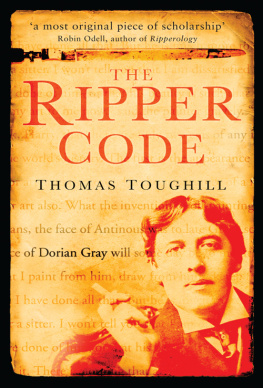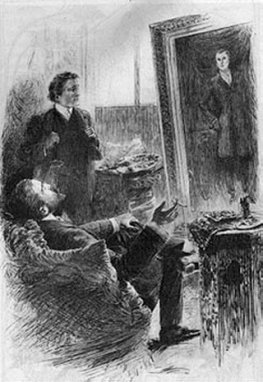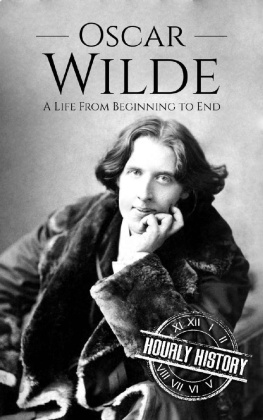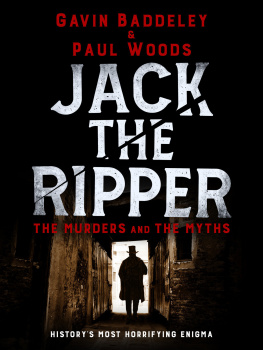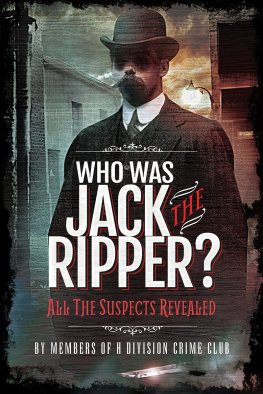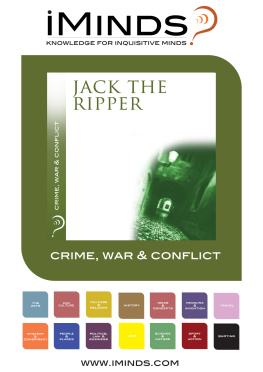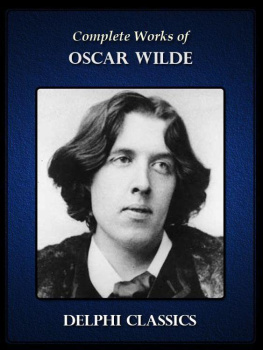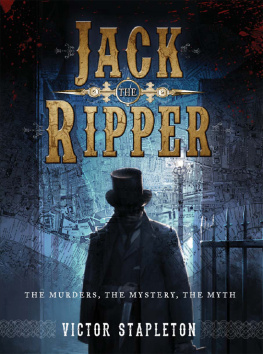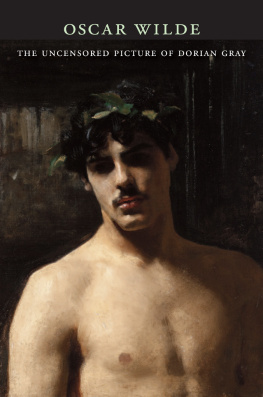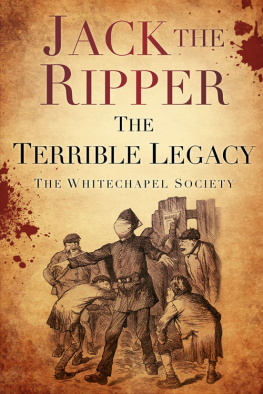T HE
R IPPER
C ODE
T HE
R IPPER
C ODE
T HOMAS T OUGHILL

First published 2008
This edition published 2009
The History Press
The Mill, Brimscombe Port
Stroud, Gloucestershire, GL 5 2 QG
www.thehistorypress.co.uk
This ebook edition first published in 2012
All rights reserved
Thomas Toughill, 2008, 2009, 2012
The right of Thomas Toughill, to be identified as the Author of this work has been asserted in accordance with the Copyrights, Designs and Patents Act 1988.
This ebook is copyright material and must not be copied, reproduced, transferred, distributed, leased, licensed or publicly performed or used in any way except as specifically permitted in writing by the publishers, as allowed under the terms and conditions under which it was purchased or as strictly permitted by applicable copyright law. Any unauthorised distribution or use of this text may be a direct infringement of the authors and publishers rights, and those responsible may be liable in law accordingly.
EPUB ISBN 978 0 7524 8717 5
MOBI ISBN 978 0 7524 8716 8
Original typesetting by The History Press
Lover and friend has thou put from me and mine acquaintance into darkness.
An extract from the 88th Psalm quoted on the frontispiece of that most famous of books on the Ripper murders, The Lodger, by Marie Belloc Lowndes, a confidante of Oscar Wilde.
Wilde told me how he had saved (Frank) Miless bacon but never referred to him again.
A statement attributed to Robert Sherard, Oscar Wildes intimate friend and biographer.
CONTENTS
A CKNOWLEDGEMENTS
I owe a special debt of gratitude to Robin Odell and Non for the help and encouragement they have given me in this project. My thanks go also to Colin Wilson for his support and enthusiasm.
I am grateful to the following people who have assisted me in my research over the years: Graeme C. Hall, Archivist of the Oxford Union; Jennifer Thorp, Archivist of New College, Oxford; Dr Robin Darwall-Smith, Archivist, Magdalen College, Oxford; Claire Hopkins, Archivist, Trinity College, Oxford; Marcus Risdell of the Garrick Club; Mrs Hatfield, Archivist of Eton College; John Bidwell of the William Andrews Clark Memorial Library, University of California; Paul Davidson, Works of Art Department, Philips of Bond Street; Robert Bowman of Sothebys; J.S. Williams, Archivist, City of Bristol; Ronald Parkinson, Assistant of Paintings, Victoria & Albert Museum; Paul Goldman, Research Assistant, The British Museum; J.P. Filedt Kok, Curator of Prints, Rijks Museum, Amsterdam; P.K. Escreet, Keeper of Special Collections, Glasgow University Library; Camilla Vignoles, Information Department, Tate Gallery; David Clarke, Department of Fine Arts, University of Hong Kong; Clarissa Schoening Morrison, University of Victoria, British Columbia; Sheila Cooke of the Local Studies Library, Nottingham; and Ralph Gee, Chief Librarian, Evening Post, Nottingham.
I wish to express my gratitude to the staff of the following: the Oxfordshire Record Office; the Nottinghamshire County Record Office; the Public Record Office; the British Library; the Greater London Record Office and History Library; the Royal Academy of Arts; the Printmakers Council; the Mitchell Library, Glasgow; and the Department of English Literature, University of Glasgow.
PAPERBACK EDITION
I would like to thank the following who helped me in the writing of this paperback edition: Graeme C. Hall, Archivist, the Oxford Union; Mrs Elizabeth Boardman, Archivist, Brasenose College, Oxford; Geoffrey Bourne-Taylor, Secretary, Apollo University Lodge no 357, Oxford; Emma Butterfield, Picture Librarian, National Portrait Gallery; Philip Rood, Media Relations Manager, VT Group PLC; P. Hatfield, Eton College; and Hugh McCormick, President, Vincents Club, Oxford.
Once again, I owe a special debt to Robin Odell and Non. Robins generosity of spirit and gentlemanly behaviour are rare commodities indeed.
L IST OF P LATES
F OREWORD
This book is the culmination of a project that has evolved and taken shape over two decades. Thomas Toughill first mentioned his ideas to me in the late 1980s and he has been content to let them mature while he acquired further components for his intriguing matrix.
In the intervening years, he has done many things; served as a Special Branch police officer, taught history and written other books. Like any good researcher, he has frequented libraries, archives and hunted down all manner of sources to garner information and supporting detail. The Ripper Code, therefore, is not a hurriedly written account intended to capitalise on sensational claims. It is a considered, thoughtful thesis which the author presents to his readers. And it has been worth the wait.
Many books about the Ripper have appeared during this interlude, some airing new suspects, others presenting familiar names in a different guise. A few authors have even aspired to claims of finality with variations on the theme that their theories have allowed the case to be closed. Such claims lack substantiation, but hyperbole has been a strong theme in the history of Ripper literature. Fortunately, this has been balanced to some extent by reliable works of reference which have established a respectable corpus of knowledge and a basis for future research.
Thomas Toughill makes no exaggerated claims for his views; he writes only of having undertaken a quest. He takes a refreshing look at the murders themselves, examining new angles and perspectives and analysing the way events have been interpreted. There is none of the tired old re-hashing of overcooked theories and fiction posing as something more substantial. Of course, he retells the story of the crimes as they unfolded but in a way that establishes them as necessary coordinates for the reader. He avoids any temptation, so prevalent in books on this subject, to swamp the reader with detail.
He takes a new look at some of the touchstones of the Ripper story such as Sir Melville Macnaghtens notes, the murderers modus operandi and police politics. There are also insights into the nineteenth century world of art and literature which dovetail into his thesis. The author gives the reader sufficient information with which to navigate, while moving the narrative forward in a measured fashion towards its conclusion. This is a skill drawn partly from his background as an historian but also from his instinct as a writer seeking to engage with his reader. As a result, The Ripper Code contains no contrived persuasion and no attempts to seduce with shrill, overblown arguments. The style is robust, measured and engagingly matter-of-fact.
Thomas Toughill has constructed a beguiling matrix into which he places the individual he believes to have been Jack the Ripper. Is it the end of the quest to identify the killer whose name has eluded legions of theorists for over a hundred years? Only the reader can judge, but the journey of discovery is certainly worthwhile.
Robin Odell
Author of Ripperology: A Study of the Worlds First
Serial Killer and a Literary Phenomenon.
T HE S ETTING

... No one who was living in London that autumn will forget the terror created by these murders. Even now I can recall the foggy evenings, and hear again the raucous cries of the newspaper boys: Another horrible murder, murder, mutilation, Whitechapel! Such was the burden of their ghastly song; and, when the double murder of 30th September took place the exasperation of the public at the non-discovery of the perpetrator knew no bounds, and no servant-maid deemed her life safe if she ventured out to post a letter after ten oclock at night. And yet this panic was quite unreasonable. The victims, without exception, belonged to the lowest dregs of female humanity, who avoid the police and exercise every ingenuity in order to remain in the darkest corners of the most deserted alleys.
Next page
